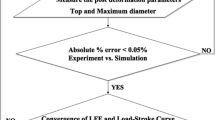Abstract
In the hot forging process of aluminum piston using water-soluble lubricants, the lubricant layer is often peeled off due to excessive deformation of the material during forming, which may result in direct contact between the material and the die, thereby partially increasing the friction. The constant friction in the Finite element (FE) analysis of this process sometimes results in a completely different result from the actual material flow. Therefore, this study was designed to investigate the friction condition to accurately predict the material flow in the FE analysis. The FE analysis was performed for various material temperatures and friction parameters and the proper friction condition was also derived to remove forging defects. Finally, the forging test was carried out for the initial specimens produced by three different methods to verify the analytical results and eliminate the forging defects. The results showed that the friction depends on the effective strain in the FE analysis and the critical value to increase friction is approximately 1.5–1.8. In addition, among the three different specimens, the shot peened specimen can remove the forging defect by increasing the amount and uniformity of the lubricant on its surface.



















Similar content being viewed by others
References
Oh, S. I. (1994). Simulation and metal forming processes. In Proceedings of Korean Society of Plastic Conference, pp. 7–21.
Kim, Y. J., & Choi, C. H. (2009). A study on life estimation of hot forging die. International Journal of Precision Engineering and Manufacturing-Green Technology, 10(3), 105–113.
Jeon, H. W., Yoon, J. H., & Lee, J. H. (2014). Forging test of Mg–Sn–Al–Zn series alloy under warm forming conditions. International Journal of Precision Engineering and Manufacturing-Green Technology, 15(10), 2127–2132.
Park, D. H., Kwon, H. D., & Kwon, H. H. (2019). Development of cam ring gear parts of large diameter for truck clutch using hot-cold complex forging technology of small bar. International Journal of Precision Engineering and Manufacturing-Green Technology, 20(5), 827–836.
Joun, M. S., Moon, H. K., & Hwang, S. M. (1996). Consideration on Frictional Laws And Their Effect On Finite Element Solutions In Bulk Metal Forming. Journal of the Korean Society for Precision Engineering, 13(2), 102–109.
Sung, J. U., Cho, S. H., Lee, H. J., & Lee, Y. S. (2011). Computation of high temperature friction coefficient of SCM435 steel. Transactions of Materials Processing, 20(3), 243–249.
Hung, J. C., & Huang, C. C. (2012). Evaluation of friction in ultrasonic vibration-assisted press forging using double cup extrusion tests. International Journal of Precision Engineering and Manufacturing-Green Technology, 13(12), 2103–2108.
Lee, J. S., Yoon, J. H., Lee, J. H., Kim, S. H., & Hong, E. C. (2014). Finite element analysis for optimizing the initial thickness of an under-drive brake piston used in an automatic transmission. Transactions of Materials Processing, 23(2), 95–102.
Jin, H. T., Choi, S. D. & Joun, M. S. (2015). Experimental and numerical studies on cold forging of an aluminum auto part. In Proceedings of Korean Society of Plastic Conference, pp. 109–112.
You, Y. H. (2012). A study on the forming conditions of a forging piston by using the finite element simulation and the taguchi method. Journal of the Korea Academia-Industrial Cooperation, 13(5), 1990–1995.
Tzou, G. Y., Hwang, Y. M., & Teng, H. Y. (2014). Study on rotating compression forming of double-layer clad ring considering coulomb friction. International Journal of Precision Engineering and Manufacturing-Green Technology, 1(3), 191–199.
Yoon, J. H., Lee, S. I., Jeon, H. W., Lee, J. H., & Lee, J. H. (2013). Study on the lubrication characteristics at the elevated temperature in hot forging test with extruded AZ80 Mg alloy. Transactions of Materials Processing, 22(2), 108–113.
Kim, D. W., Kim, Y. R., Lee, G. A., Choi, H. J., Yun, D. J., Shin, Y. C., et al. (2012). Friction characteristics of warm a forging lubricant containing nano graphite powder. Transactions of Materials Processing, 21(1), 13–18.
Kim, J. H., & Kim, C. (2010). Analysis of filling and stresses in the hot forging process depending on flange die shapes. Transactions of the Korean Society of Mechanical Engineers, 34(4), 423–430.
Hwang, H. Y., Jeong, S. W. and Joun, M. S. (2016). Numerical and experimental study on die deformation in hot forging by rigid-thermoviscoplastic finite element method. In Proceedings of Korean Society of Plastic Conference, pp. 27–28.
Hong, E. J., & Kang, H. S. (2017). Development of forged piston for weight-reduction. Transaction of Korean Society of Automotive Engineers, 25(1), 111–115.
Kim, Y. H., Bae, W. B., Kim, J. C., & Kim, H. S. (1997). A study on the development of aluminum piston by forging process. Journal of the Korean Society for Precision Engineering, 14(9), 30–36.
Choi, J. I., Kim, J. H., Park, J. H., Kim, Y. H., & Choi, J. C. (2006). A study on manufacture of aluminum automotive piston by thixoforging. Journal of the Korean Society for Precision Engineering, 23(1), 136–144.
Yeom, S. H., Lee, B. S., Rho, B. R., Seo, K. S., & Hong, S. I. (2004). A study on forging process about preform of articulated piston for diesel engine. Transactions of Materials Processing, 13(7), 635–641.
“AFDEX V17 User Manual,” MFRC Co., 2017.
Rebelo, N., & Kobayshi, S. (1980). A coupled analysis of viscoplastic deformation and heat transfer—I, theoretical considerations. International Journal of Mechanical Sciences, 22, 699–705.
Acknowledgements
This paper was supported by Korea Institute of Industry Technology(KITECH EO-19-0042), the World-Class 300 Project(CENTRAL CO.) and the Lightweight Material National Strategy project(10081335) funded by the Ministry of Trade, Industry and Energy.
Author information
Authors and Affiliations
Corresponding author
Additional information
Publisher's Note
Springer Nature remains neutral with regard to jurisdictional claims in published maps and institutional affiliations.
Rights and permissions
About this article
Cite this article
Lee, SW., Jo, JW., Joun, MS. et al. Effect of Friction conditions on Material Flow in FE Analysis of Al Piston Forging Process. Int. J. Precis. Eng. Manuf. 20, 1643–1652 (2019). https://doi.org/10.1007/s12541-019-00189-8
Received:
Revised:
Accepted:
Published:
Issue Date:
DOI: https://doi.org/10.1007/s12541-019-00189-8




